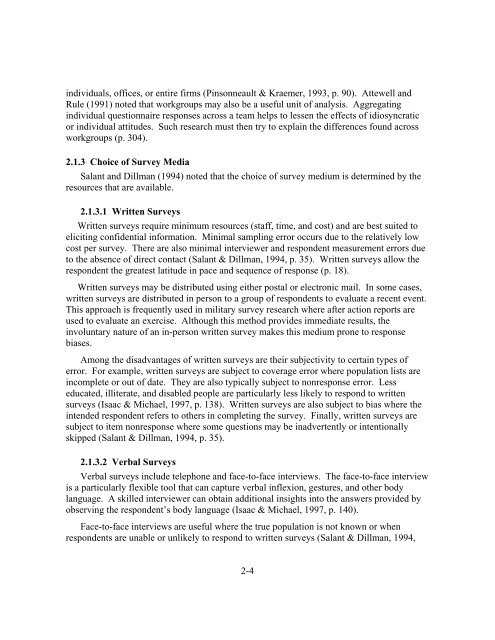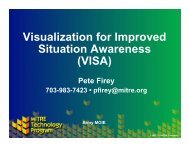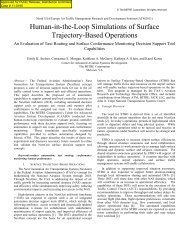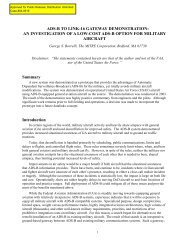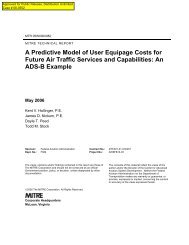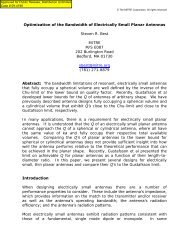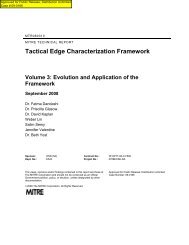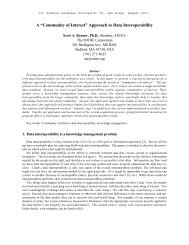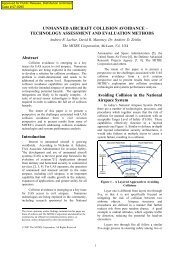Fundamentals of Survey Research Methodology - Mitre
Fundamentals of Survey Research Methodology - Mitre
Fundamentals of Survey Research Methodology - Mitre
You also want an ePaper? Increase the reach of your titles
YUMPU automatically turns print PDFs into web optimized ePapers that Google loves.
individuals, <strong>of</strong>fices, or entire firms (Pinsonneault & Kraemer, 1993, p. 90). Attewell and<br />
Rule (1991) noted that workgroups may also be a useful unit <strong>of</strong> analysis. Aggregating<br />
individual questionnaire responses across a team helps to lessen the effects <strong>of</strong> idiosyncratic<br />
or individual attitudes. Such research must then try to explain the differences found across<br />
workgroups (p. 304).<br />
2.1.3 Choice <strong>of</strong> <strong>Survey</strong> Media<br />
Salant and Dillman (1994) noted that the choice <strong>of</strong> survey medium is determined by the<br />
resources that are available.<br />
2.1.3.1 Written <strong>Survey</strong>s<br />
Written surveys require minimum resources (staff, time, and cost) and are best suited to<br />
eliciting confidential information. Minimal sampling error occurs due to the relatively low<br />
cost per survey. There are also minimal interviewer and respondent measurement errors due<br />
to the absence <strong>of</strong> direct contact (Salant & Dillman, 1994, p. 35). Written surveys allow the<br />
respondent the greatest latitude in pace and sequence <strong>of</strong> response (p. 18).<br />
Written surveys may be distributed using either postal or electronic mail. In some cases,<br />
written surveys are distributed in person to a group <strong>of</strong> respondents to evaluate a recent event.<br />
This approach is frequently used in military survey research where after action reports are<br />
used to evaluate an exercise. Although this method provides immediate results, the<br />
involuntary nature <strong>of</strong> an in-person written survey makes this medium prone to response<br />
biases.<br />
Among the disadvantages <strong>of</strong> written surveys are their subjectivity to certain types <strong>of</strong><br />
error. For example, written surveys are subject to coverage error where population lists are<br />
incomplete or out <strong>of</strong> date. They are also typically subject to nonresponse error. Less<br />
educated, illiterate, and disabled people are particularly less likely to respond to written<br />
surveys (Isaac & Michael, 1997, p. 138). Written surveys are also subject to bias where the<br />
intended respondent refers to others in completing the survey. Finally, written surveys are<br />
subject to item nonresponse where some questions may be inadvertently or intentionally<br />
skipped (Salant & Dillman, 1994, p. 35).<br />
2.1.3.2 Verbal <strong>Survey</strong>s<br />
Verbal surveys include telephone and face-to-face interviews. The face-to-face interview<br />
is a particularly flexible tool that can capture verbal inflexion, gestures, and other body<br />
language. A skilled interviewer can obtain additional insights into the answers provided by<br />
observing the respondent’s body language (Isaac & Michael, 1997, p. 140).<br />
Face-to-face interviews are useful where the true population is not known or when<br />
respondents are unable or unlikely to respond to written surveys (Salant & Dillman, 1994,<br />
2-4


